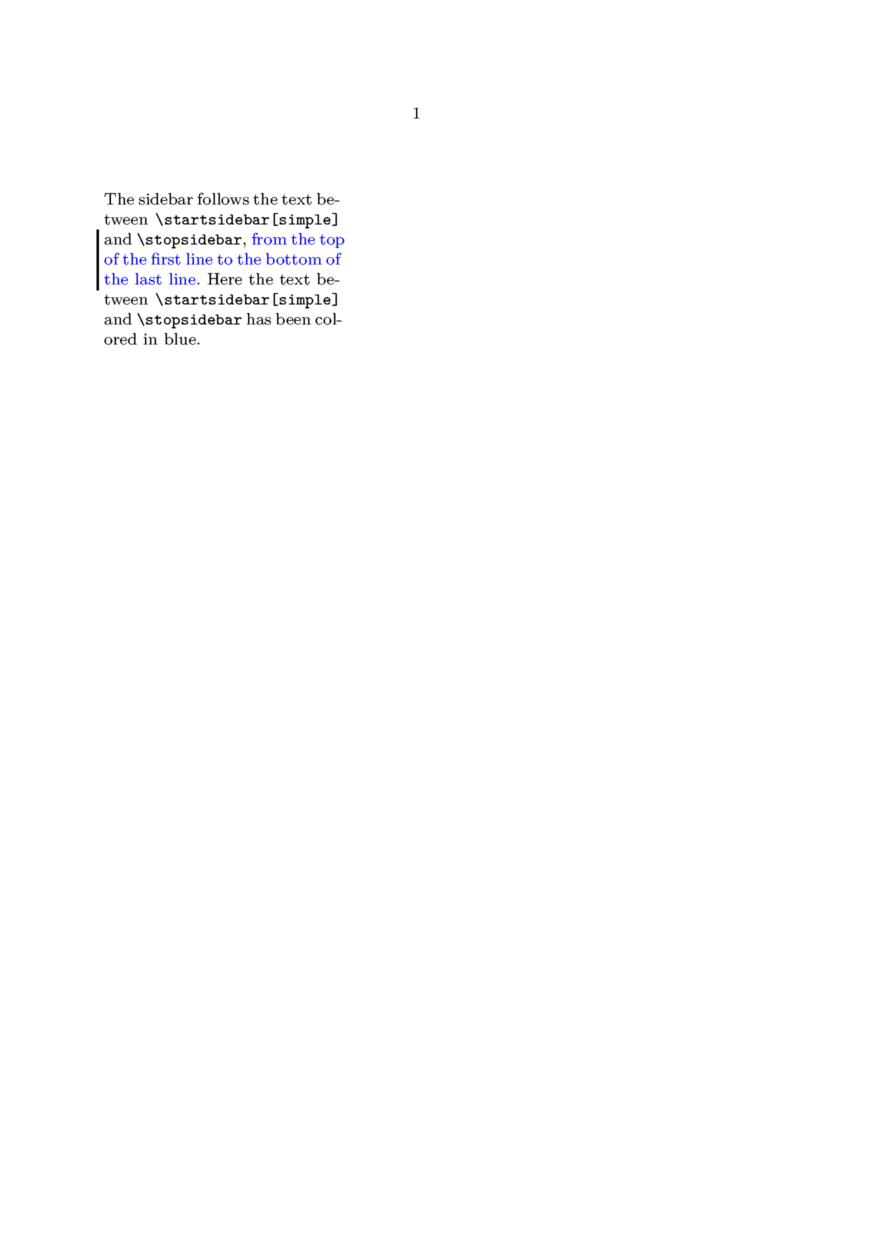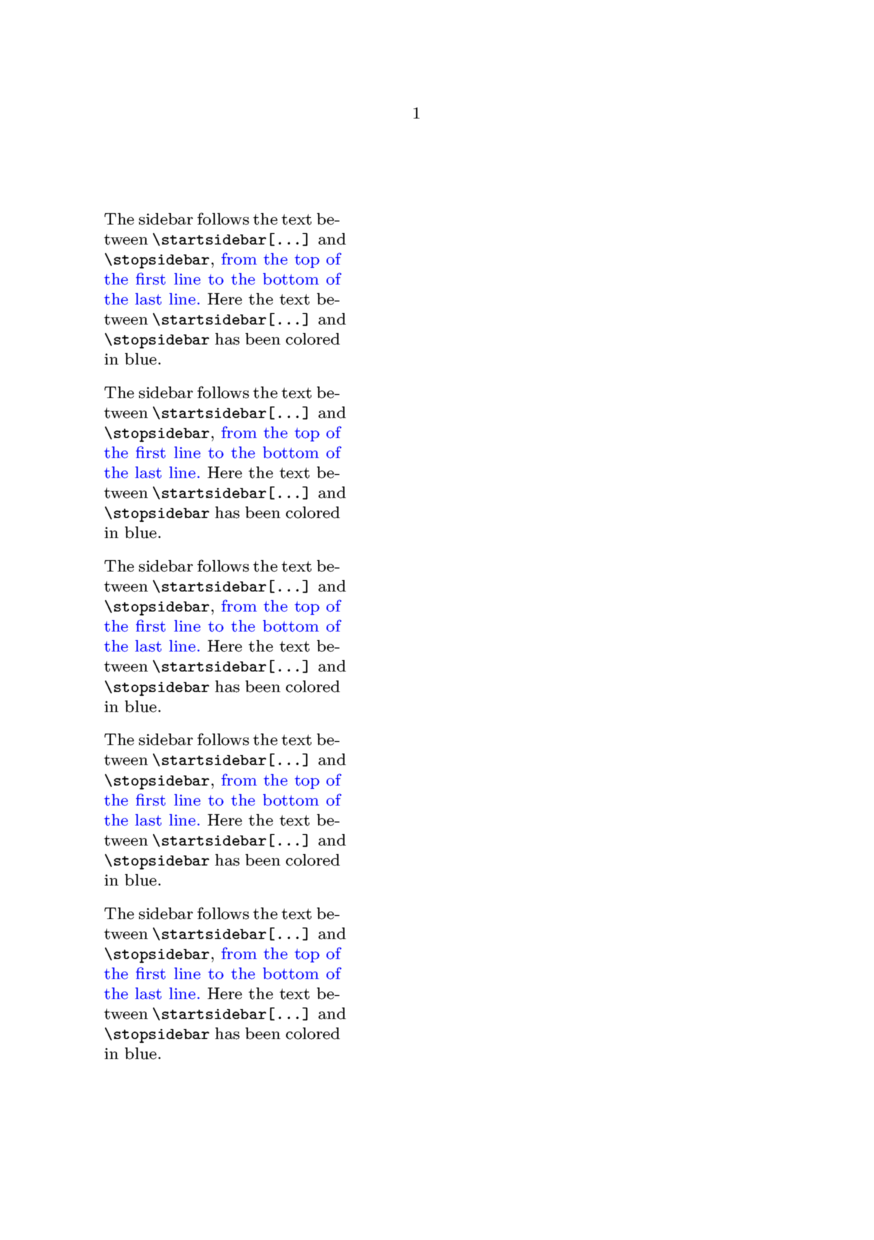Difference between revisions of "Command/setupsidebar"
(first version of \setupsidebar (work in progress)) |
(No difference)
|
Revision as of 17:17, 28 April 2021
Contents
\setupsidebar
Summary
The command \setupsidebar is used to customize vertical bars.
They are drawn starting from the left edge of the text, but you can move them anywhere horizontally.
\startsidebar[...] ... \stopsidebar can be placed inside the text of a paragraph to "vertically underline"
portions of text. The bars follow the lines where there's the text between \startsidebar[...] and \stopsidebar.
They are drawn from the top of the first line to the bottom of the last line of that portion of text.
You can fine-tune the starting and ending points of a bar with topoffset and bottomoffset.
\startsidebar[...] ... \stopsidebar can be nested: in this case the distance parameter is used to move the second bar (the inner one) relatively to the first one.
Settings
| \setupsidebar[...,...][...=...,...] | |
| [...,...] | name |
| rulethickness | dimension |
| rulecolor | color |
| alternative | number |
| topoffset | dimension |
| bottomoffset | dimension |
| distance | dimension |
| leftmargindistance | dimension |
| level | number |
| Option | Explanation | ||||
|---|---|---|---|---|---|
| rulethickness |
| ||||
| rulecolor |
| ||||
| alternative |
| ||||
| topoffset |
| ||||
| bottomoffset |
| ||||
| distance |
| ||||
Description
Examples
A simple side bar
\definesidebar[simple][rulethickness=1pt,distance=3pt] \starttext \hsize=4cm The sidebar follows the text between \type{\startsidebar[simple]} and \type{\stopsidebar}, \startsidebar[simple] {\blue from the top of the first line to the bottom of the last line.}\stopsidebar Here the text between \type{\startsidebar[simple]} and \type{\stopsidebar} has been colored in blue.\par \stoptext
produces

Custom fancy sidebars
You can define fancy, zig zag bars redefining the anch_sidebars_draw macro:
\definesidebar[zigzag1][rulecolor=black,distance=4pt,rulethickness=1pt,alternative=2] \definesidebar[zigzag2][rulecolor=red,distance=4pt,rulethickness=1pt,alternative=3] \definesidebar[wave1][rulecolor=blue,distance=4pt,rulethickness=1pt,alternative=4] \definesidebar[wave2][rulecolor=cyan,distance=4pt,rulethickness=1pt,alternative=5] \definesidebar[obliquedashes][rulecolor=darkgreen,distance=4pt,rulethickness=1pt,alternative=6] \startMPcode % draws a bar repeating a pattern defined from (0,0) to (0,1) def draw_pattern_bar(expr a, b, pattern, patternlength, patternheight, linewidth, linecolor) = draw image ( begingroup ; save p, q, stp ; pair p, q, stp ; stp := ( ( b - a ) / arclength( a -- b ) ) * patternlength ; path q ; q := pattern xscaled patternlength yscaled patternheight rotated (angle(stp)) ; p := a ; forever : draw q shifted p withpen pencircle scaled linewidth withcolor linecolor ; p := p + stp ; exitif arclength( a -- p ) > arclength( a -- b ) ; endfor ; endgroup ; clip currentpicture to (xpart llcorner currentpicture, ypart b) -- (xpart lrcorner currentpicture, ypart b) -- (xpart urcorner currentpicture, ypart a) -- (xpart ulcorner currentpicture, ypart a) -- cycle ; ) ; enddef ; % modified from metapost/context/base/mpiv/mp-apos.mpiv to add alternatives def anch_sidebars_draw (expr p_b_self, p_e_self, y_b_self, y_e_self, h_b_self, d_e_self, x, y, w, h, alternative, distance, linewidth, linecolor, topoffset, bottomoffset) = % beware, we anchor at (x,y) begingroup ; if alternative = 1 : interim linecap := rounded ; else : interim linecap := butt ; fi ; save a, b ; pair a, b ; if p_b_self = p_e_self : a := (-distance,y_b_self+h_b_self-y) ; b := (-distance,y_e_self-d_e_self-y) ; elseif RealPageNumber = p_b_self : a := (-distance,y_b_self+h_b_self-y) ; b := (-distance,0) ; elseif RealPageNumber = p_e_self : a := (-distance,h) ; b := (-distance,y_e_self-d_e_self-y) ; else : a := (-distance,h) ; b := (-distance,0) ; fi ; a := (xpart a, min(ypart a + topoffset, h)) ; b := (xpart b, max(ypart b - bottomoffset,0)) ; if alternative = 2 : draw_pattern_bar( a, b, ((0,0)--(0.25,-0.5)--(0.75,0.5)--(1,0)), 2pt, 2pt, linewidth, linecolor ) ; elseif alternative = 3 : draw_pattern_bar( a, b, ((0,0)--(0.25,-0.5)--(0.75,0.5)--(1,0)), 4pt, 1.5pt, linewidth, linecolor ) ; elseif alternative = 4 : draw_pattern_bar( a, b, ( ((0,0) .. controls (0,0.5) and (0.5,0.5) .. (0.5,0)) -- ((0.5,0) .. controls (0.5,-0.5) and (1,-0.5) .. (1,0)) ), 6pt, 4pt, linewidth, linecolor ) ; elseif alternative = 5 : draw_pattern_bar( a, b, ( (0,0) .. controls (0,1) and (1,1) .. (1,0) ), 4pt, 2pt, linewidth, linecolor ) ; elseif alternative = 6 : draw_pattern_bar( a, b, ( (0,0.5) .. (1,-0.5) ), 4pt, 2pt, linewidth, linecolor ) ; else : draw a -- b if alternative = 1 : dashed (withdots scaled (linewidth/2)) fi withpen pencircle scaled linewidth withcolor linecolor ; fi ; endgroup ; enddef ; \stopMPcode \def\samplewithbar#1{The sidebar follows the text between \type{\startsidebar[...]} and \type{\stopsidebar}, \startsidebar[#1] {\blue from the top of the first line to the bottom of the last line.}\stopsidebar Here the text between \type{\startsidebar[...]} and \type{\stopsidebar} has been colored in blue.\par \blank} \starttext \hsize=4cm \samplewithbar{zigzag1} \samplewithbar{zigzag2} \samplewithbar{wave1} \samplewithbar{wave2} \samplewithbar{obliquedashes} \stoptext

The metapost macro draw_pattern_bar draws a repeating pattern along the bar length.
The pattern is a sort of waveform defined with a path from (0,0) to (1,0).
Its bounding box should have a height of 1, so that the base waveform has amplitude 1.
The length of the pattern and its "amplitude" are magnified
according to patternlength and patternheight.